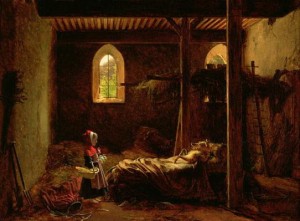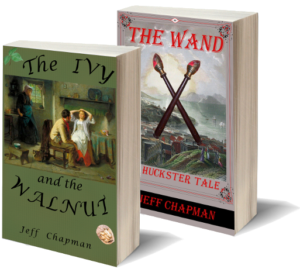
Little Red Riding Hood (c. 1820) by Fleury François Richard (1777–1852).
I suspect everybody knows what a wolf (Canis lupus) is: a furry, four-legged creature with big teeth that lives and hunts in packs and sings to the moon and plays a very important role in a healthy ecosystem. Deer, elk, and moose might have a different opinion.
Wolf derives from the Old English wulf—meaning the animal, a wolfish person, or a devil—and descends from the Proto-Germanic *wulfaz. Cognates appear in Old Saxon wulf, Old Norseulfr, German wolf, and Gothic wulfs.
Wolves have been both revered and despised. In Native American cultures, wolves play a prominent role in folktales and mythology, figuring in the origin stories of several tribes including the Quileute, Kwakiutl, Shoshone, and Lakota. The stories associate wolves with courage, loyalty, and hunting. “The Tale of Two Wolves,” a Cherokee parable, describes our dual natures as an internal battle between two wolves: one filled with harmony, the other anger. In Norse mythology, the wolf Fenrir is the son of Loki. Japanese grain farmers have been known to worship wolves at shrines and leave food offerings for them, hoping the wolves will kill the boars and deer feeding on their crops. In other cultures, wolves are part of the foundation myths. In Roman mythology, for example, Romulus and Remus, the founders of Rome, are nursed by a she wolf. Cultures centered on livestock, especially sheep, tend to view wolves differently. Consider Aesop’s fable “The Boy Who Cried Wolf.”
Wolves have frequently been associated with lust or voracious behavior. The Roman slang word lupa, meaning whore, literally means she-wolf. (You have to wonder how this colors the Romulus and Remus story.) The word wolf was initially associated with prostitutes and sexually aggressive females but the word transformed to be symbolic of male lust. Nowhere is this association of wolf and male sexual predator more evident than in Charles Perrault’s version of “Little Red Riding Hood.”
The wolf, seeing her come in, said to her, hiding himself under the bedclothes, “Put the cake and the little pot of butter upon the stool, and come get into bed with me.”
Little Red Riding Hood took off her clothes and got into bed. She was greatly amazed to see how her grandmother looked in her nightclothes, and said to her, “Grandmother, what big arms you have!”
“All the better to hug you with, my dear.”
“Grandmother, what big legs you have!”
“All the better to run with, my child.”
“Grandmother, what big ears you have!”
“All the better to hear with, my child.”
“Grandmother, what big eyes you have!”
“All the better to see with, my child.”
“Grandmother, what big teeth you have got!”
“All the better to eat you up with.”
And, saying these words, this wicked wolf fell upon Little Red Riding Hood, and ate her all up.
Moral: Children, especially attractive, well bred young ladies, should never talk to strangers, for if they should do so, they may well provide dinner for a wolf. I say “wolf,” but there are various kinds of wolves. There are also those who are charming, quiet, polite, unassuming, complacent, and sweet, who pursue young women at home and in the streets. And unfortunately, it is these gentle wolves who are the most dangerous ones of all.
—from Andrew Lang’s translation in The Blue Fairy Book
(London, ca. 1889), pp. 51-53.


Ha! I’ve never read that version! Yes, do watch out for those wolves!
Wow! I have some of the Andrew Lang fairy tale books, but I don’t think I’ve read that version! I have to agree with his assessment, though. And, now I wonder more about the Romulus and Remus story. Just who were they raised by?
Thanks for your thought-provoking post, Jeff!